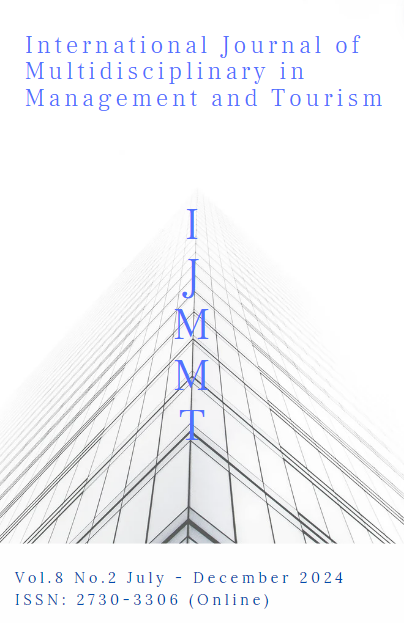Factors Affecting Hospitals Employee Performance in Taian City, The People's Republic of China
Main Article Content
Abstract
Working in every organization requires success and achieving the goals that have been set. Quality human resource management therefore It is very important to bring success. Organizations and every organization will give the importance of leadership by Seeking new ways to develop personnel to be a good leader with ethics, patience, and sacrifice. Behave as a good example for your followers. This article is a research article have a purpose (1) To study factors affecting the work performance of hospital employees in Taian city, the People's Republic of China. (2) To development hospitals employee performance in Taian city, the People's Republic of China. The population is 30,681 employees from 105 hospitals in Taian. Using a questionnaire as a tool to collect data. The statistical methods used in data analysis for quantitative research include descriptive statistical analysis, correlation analysis, factor analysis and structural equation modeling. Analysis data by Descriptive statistics and Content Analysis. The research results were found as follows; Factors affecting the performance of hospital employees in Taian City People's Republic of China is Transformational leadership, organizational justice, and internal motivation all have an important impact on employee performance. It was found that modeling transformational leadership behavior has a positive impact on improving employee performance. in actual work A supervisor is one of the people employees have the most contact with. Hospital leaders need to have quite a high level of morality. dare to take responsibility and set an example for the employees they lead. Leaders should also pay attention to the process of interacting with employees and set an example for their employees. The results show that all four dimensions of organizational justice and all five dimensions of intrinsic motivation have a direct positive impact on employee performance.
Article Details

This work is licensed under a Creative Commons Attribution-NonCommercial-NoDerivatives 4.0 International License.
References
Adams, J. S. (1965). Inequity in social exchange. In Advances in experimental social psychology (Vol. 2, pp. 267-299). Academic Press.
Avolio, B. J., & Bass, B. M. (1995). Individual consideration viewed at multiple levels of analysis: A multi-level framework for examining the diffusion of transformational leadership. The Leadership Quarterly, 6(2), 199-218.
Bernardin, H. J., Cooke, D. K., & Villanova, P. (2000). Conscientiousness and agreeableness as predictors of rating leniency. Journal of Applied Psychology, 85(2), 232–236. https://doi.org/10.1037/0021-9010.85.2.232
Brumbrach, G. B. (1988). Some ideas, issues and predictions about information management. Public Personnel Management, 17(4), 387-402.
Chen, Y. C., Chiu, Y. H., Chang, T. H., & Lin, T. Y. (2023). Sustainable development, government efficiency, and people’s happiness. Journal of Happiness Studies, 24(4), 1549-1578. https://doi.org/10.1007/s10902-023-00658-y
Dillon, J. T. (1988). The remedial status of student questioning. Journal of Curriculum Studies, 20(3), 197-210. https://doi.org/10.1080/0022027880200301
DuBrin, A. J. (2012). Essentials of management. South-Western.
Festinger, L. (1962). Cognitive dissonance. Scientific American, 207(4), 93-106. https://doi.org/10.1038/scientificamerican1062-93
Jensen, E. A., Dysart, K., Gantz, M. G., McDonald, S., Bamat, N. A., Keszler, M., Kirpalani, H., Laughon, M. M., Poindexter, B. B., Duncan, A. F., Yoder, B. A., Eichenwald, E. C., & DeMauro, S. B. (2019). The diagnosis of bronchopulmonary dysplasia in very preterm infants. An evidence-based approach. American Journal of Respiratory and Critical Care Medicine, 200(6), 751-759. 10.1164/rccm.201812-2348OC
Kane, V. E. (1986). Process capability indices. Journal of Quality Technology, 18(1), 41-52. https://doi.org/10.1080/00224065.1986.11978984
Grant, R. M. (1996). Toward a knowledge‐based theory of the firm. Strategic Management Journal, 17(S2), 109-122. https://doi.org/10.1002/smj.4250171110
Katzell, R. A., & Thompson, D. E. (1990). Work motivation: Theory and practice. American Psychologist, 45(2), 144–153. https://doi.org/10.1037/0003-066X.45.2.144
Laud, R., Arevalo, J., & Johnson, M. (2015). The changing nature of managerial skills, mindsets and roles: Advancing theory and relevancy for contemporary managers. Journal of Management & Organization, 22(4), 435–456. https://doi.org/10.1017/ jmo.2015.48
Lee, M. K., & Turban, E. (2001). A trust model for consumer internet shopping. International Journal of Electronic Commerce, 6(1), 75-91. https://doi.org/10.1080/10864415.2001. 11044227
Leithwood, K., & Steinbach, R. (1992). Improving the problem-solving expertise of school administrators: Theory and practice. Education and Urban Society, 24(3), 317-345. https://doi.org/10.1177/0013161X9302900300
McClelland, D. C. (1973). Testing for competence rather than for "intelligence." American Psychologist, 28(1), 1–14. https://doi.org/10.1037/h0034092
Morgan, G. (1989). Creative organization theory: A resource book. Sage.
Okun, A. M. (1959). A review of some economic forecasts for 1955-57. The Journal of Business, 32(3), 199-211.
Pinder, C. C. (2014). Work motivation in organizational behavior. Psychology Press.
Pritchard, R. D., Campbell, K. M., & Campbell, D. J. (1977). Effects of extrinsic financial rewards on intrinsic motivation. Journal of Applied Psychology, 62(1), 9–15. https://doi.org/10.1037/0021-9010.62.1.9
Tayyab, S. (2007). An empirical assessment of organizational commitment measures. Pakistan Journal of Psychological Research, 22(1-2), 1-22.
Tyler, T. R. (1989). The psychology of procedural justice: A test of the group-value model. Journal of Personality and Social Psychology, 57(5), 830–838. https://doi.org/ 10.1037/0022-3514.57.5.830
Shah, S. I. H., Khan, A. Z., Bokhari, R. H., & Raza, M. A. (2011). Exploring the impediments of successful ERP implementation: A case study in a public organization. International Journal of Business and Social Science, 2(22), 289-296.
Shin, S. J., & Zhou, J. (2003). Transformational leadership, conservation, and creativity: Evidence from Korea. Academy of Management Journal, 46(6), 703–714. https://doi.org/10.2307/30040662
Waldman, D. A., Ramirez, G. G., House, R. J., & Puranam, P. (2001). Does leadership matter? CEO leadership attributes and profitability under conditions of perceived environmental uncertainty. Academy of Management Journal, 44(1), 134–143. https://doi.org/10.2307/3069341

